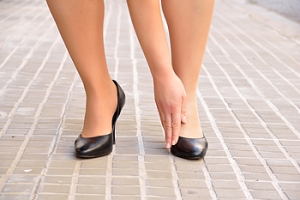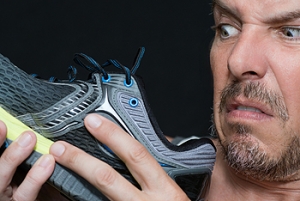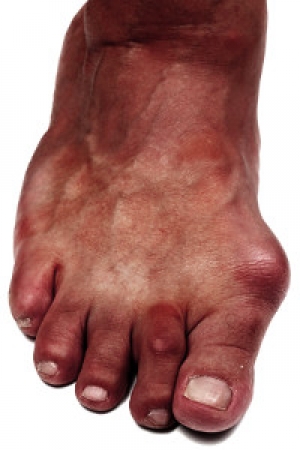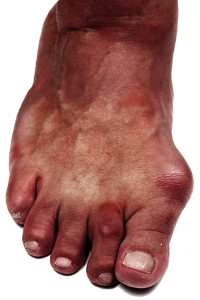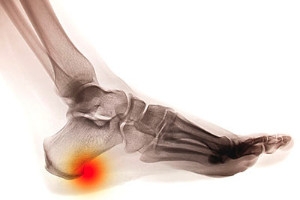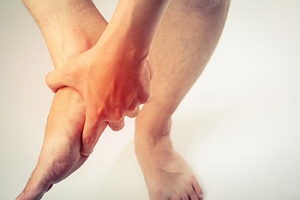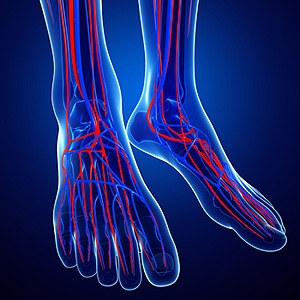Dallas Metro / North Texas
(214) 710-1028
Super User
How Certain Conditions May be Avoided by Choosing the Correct Shoe
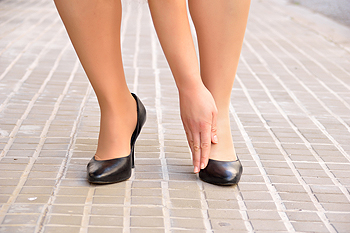 Many people have experienced pain in the feet after frequently wearing high heels, and research has shown this may cause possible damage to the feet. For many women, the muscles in the feet may endure additional strain as a result of shortened calf muscles. The feet may be permanently flexed in addition to the toes existing in a pointed position. Other conditions involving the feet may include hammer toes, ligament tears, or bunions. Some women may be at a greater risk for fractures if high heels are worn socially and balance may be affected by alcohol. Despite the risks of possible foot injuries, many women will continue to wear high heels on a daily basis. By choosing proper shoes to wear, certain foot conditions may be avoided. These may include wearing shoes with a larger area for the toes to move about and keeping the heel as short as possible. If you would like additional information about how your feet are affected by high heels, please consult with a podiatrist.
Many people have experienced pain in the feet after frequently wearing high heels, and research has shown this may cause possible damage to the feet. For many women, the muscles in the feet may endure additional strain as a result of shortened calf muscles. The feet may be permanently flexed in addition to the toes existing in a pointed position. Other conditions involving the feet may include hammer toes, ligament tears, or bunions. Some women may be at a greater risk for fractures if high heels are worn socially and balance may be affected by alcohol. Despite the risks of possible foot injuries, many women will continue to wear high heels on a daily basis. By choosing proper shoes to wear, certain foot conditions may be avoided. These may include wearing shoes with a larger area for the toes to move about and keeping the heel as short as possible. If you would like additional information about how your feet are affected by high heels, please consult with a podiatrist.
High heels have a history of causing foot and ankle problems. If you have any concerns about your feet or ankles, contact Kellvan Cheng, DPM from Elite Foot & Ankle. Our doctor can provide the care you need to keep you pain-free and on your feet.
Effects of High Heels on the Feet
High heels are popular shoes among women because of their many styles and societal appeal. Despite this, high heels can still cause many health problems if worn too frequently.
Which Parts of My Body Will Be Affected by High Heels?
- Ankle Joints
- Achilles Tendon – May shorten and stiffen with prolonged wear
- Balls of the Feet
- Knees – Heels cause the knees to bend constantly, creating stress on them
- Back – They decrease the spine’s ability to absorb shock, which may lead to back pain. The vertebrae of the lower back may compress.
What Kinds of Foot Problems Can Develop from Wearing High Heels?
- Corns
- Calluses
- Hammertoe
- Bunions
- Morton’s Neuroma
- Plantar Fasciitis
How Can I Still Wear High Heels and Maintain Foot Health?
If you want to wear high heeled shoes, make sure that you are not wearing them every day, as this will help prevent long term physical problems. Try wearing thicker heels as opposed to stilettos to distribute weight more evenly across the feet. Always make sure you are wearing the proper shoes for the right occasion, such as sneakers for exercising. If you walk to work, try carrying your heels with you and changing into them once you arrive at work. Adding inserts to your heels can help cushion your feet and absorb shock. Full foot inserts or metatarsal pads are available.
If you have any questions please feel free to contact our office located in Carrollton, TX . We offer the newest diagnostic and treatment technologies for all your foot and ankle needs.
Why High Heels Are Not Ideal for Healthy Feet
It is no secret that high heels are uncomfortable to wear for long periods of time. Although beauty is pain, you should not sacrifice the health of your feet for a stylish heel. Wearing high heels can potentially cause many different foot conditions that may be avoided by wearing proper footwear.
The structure of high heels forces weight of your body to get shifted forward toward the ball of the foot. The higher the heel you wear, the more weight and pressure get shifted forward. The pressure that your toes may experience from wearing heels may lead to hammer toes, bunions, and ingrown toenails. Extra weight and pressure resulting from wearing heels may cause stress fractures. Furthermore, heels may cause pinched nerves which may result in Morton’s neuroma.
High heels are even more dangerous for people who are clumsy. Falling or tripping while wearing heels can cause an ankle sprain or twist.
What many people don’t know is that heels can also cause back and knee problems. In order for your body to stay balanced on heels, your spine has to sway unnaturally, which adds stress to your spine muscles. This may cause you to experience a sore lower back.
If you decide to wear high heels regardless of the risks associated with them, there are ways you can minimize their harmful effects. One way to reduce injury is to massage and stretch your legs at the end of the day. Stretching can prevent the Achilles tendons and calf muscles from becoming too tight. If you are simply looking for more height, wedges and platforms provide a better surface area to distribute the body weight across compared to thinner heels.
If you experience pain from wearing high heels, it is important to see a podiatrist before any of your symptoms become worse.
Handling Hyperhidrosis
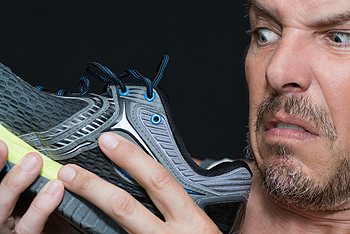 The human body produces sweat as a reaction to an increase in temperature. Since we are warm-blooded creatures, we excrete water through our pores to avoid overheating. However, it is possible for the body to produce more sweat than what is necessary; this condition is called hyperhidrosis. Hyperhidrosis may be caused by thyroid problems, hormonal fluctuation, anxiety, or medical conditions. One of the tell-tale signs of the condition is that it causes the individual to sweat regardless of the environment they are in. Sweat is meant to be a reactive condition, meaning that it occurs as a result of heat. When people have hyperhidrosis, they produce sweat without regard to the temperature. Additionally, it is common for people with the condition to only sweat in certain areas, such as the feet. If you are dealing with sweaty feet and are looking to find a solution, you should contact your podiatrist right away.
The human body produces sweat as a reaction to an increase in temperature. Since we are warm-blooded creatures, we excrete water through our pores to avoid overheating. However, it is possible for the body to produce more sweat than what is necessary; this condition is called hyperhidrosis. Hyperhidrosis may be caused by thyroid problems, hormonal fluctuation, anxiety, or medical conditions. One of the tell-tale signs of the condition is that it causes the individual to sweat regardless of the environment they are in. Sweat is meant to be a reactive condition, meaning that it occurs as a result of heat. When people have hyperhidrosis, they produce sweat without regard to the temperature. Additionally, it is common for people with the condition to only sweat in certain areas, such as the feet. If you are dealing with sweaty feet and are looking to find a solution, you should contact your podiatrist right away.
If you are suffering from hyperhidrosis contact Kellvan Cheng, DPM of Elite Foot & Ankle. Our doctor can provide the care you need to attend to all of your foot and ankle needs.
Hyperhidrosis of the Feet
Hyperhidrosis is a rare disorder that can cause people to have excessive sweating of their feet. This can usually occur all on its own without rigorous activity involved. People who suffer from hyperhidrosis may also experience sweaty palms.
Although it is said that sweating is a healthy process meant to cool down the body temperature and to maintain a proper internal temperature, hyperhidrosis may prove to be a huge hindrance on a person’s everyday life.
Plantar hyperhidrosis is considered to be the main form of hyperhidrosis. Secondary hyperhidrosis can refer to sweating that occurs in areas other than the feet or hands and armpits. Often this may be a sign of it being related to another medical condition such as menopause, hyperthyroidism and even Parkinson’s disease.
In order to alleviate this condition, it is important to see your doctor so that they may prescribe the necessary medications so that you can begin to live a normal life again. If this is left untreated, it is said that it will persist throughout an individual’s life.
A last resort approach would be surgery, but it is best to speak with your doctor to find out what may be the best treatment for you.
If you have any questions please feel free to contact our office located in Carrollton, TX . We offer the newest diagnostic and treatment technologies for all your foot and ankle needs.
Hyperhidrosis of the Feet
Each foot, on average, has about 250,000 eccrine sweat glands that produce half a pint of sweat each day. Sweating is a natural and important bodily function. It regulates the body’s temperature by cooling the skin so that it does not overheat. In individuals with hyperhidrosis, the sympathetic nervous system works in "overdrive", producing far more sweat than what is required. People with plantar hyperhidrosis experience an excess amount of sweat on their feet. It is estimated that 2% to 3% of all Americans suffer from some form of hyperhidrosis. This condition is often caused by neurologic, endocrine, infectious, and other systemic disease. Other factors that may trigger the condition are heat and emotions.
People with hyperhidrosis may notice an overabundance of sweat on their feet, along with a strong odor. The feet may also have a wet appearance coupled with infections such as athlete’s foot or toenail fungus. The sweat may even appear in low temperatures, such as during the winter months. People with plantar hyperhidrosis often need to change their socks several times throughout the day.
The specific cause of hyperhidrosis is unknown, and many believe it may be caused by over-activity. However, others believe the condition is genetic. Caffeine and nicotine are known to cause excitement and nervousness which are two emotions that may make the condition worse.
If you are looking to treat your hyperhidrosis the most important thing you should do is wash your feet every day. You may even need to wash your feet twice a day, if necessary. You should also make sure you are wearing the right socks. Wool and cotton socks are both known to be good for ventilation, meaning they allow the feet to breathe. You should avoid socks made from nylon which trap moisture and lead to sogginess. Other common treatment options are over-the-counter antiperspirants that contain a low dose of metal salt. In some cases, prescription strength antiperspirants that contain aluminum chloride hexahydrate may be necessary. In severe cases, surgery may be required.
Untreated hyperhidrosis can easily lead to complications. Some complications that may arise from the disorder include nail infections, warts, and bacterial infections. Consequently, it is important that you seek treatment from your podiatrist if you suspect that you may have plantar hyperhidrosis.
Why Do Bunions Develop?
A bunion is an abnormal growth that forms on the bottom of the big toe. Typical symptoms include swelling, pain, and redness surrounding the area of the big toe, and the entire foot may change shape as a result of the bunion. Choosing to wear poorly fitting shoes may cause this condition to develop, in addition to having a family history of bunions. This ailment may be prevented by wearing shoes that have adequate room for the toes to move freely, and shoes with a lower heel are preferred. If you enjoy running or jogging, your feet should be properly supported in running shoes that fit correctly. It’s suggested to schedule a consultation with a podiatrist who is skilled in properly diagnosing this condition. Treatment options can be discussed, which may include custom-made orthotics for temporary relief or surgery for removal of the bunion.
If you are suffering from bunion pain, contact Kellvan Cheng, DPM of Elite Foot & Ankle. Our doctor can provide the care you need to keep you pain-free and on your feet.
What Is a Bunion?
Bunions are painful bony bumps that usually develop on the inside of the foot at the joint of the big toe. As the deformity increases over time, it may become painful to walk and wear shoes. Women are more likely to exacerbate existing bunions since they often wear tight, narrow shoes that shift their toes together. Bunion pain can be relieved by wearing wider shoes with enough room for the toes.
Causes
- Genetics – some people inherit feet that are more prone to bunion development
- Inflammatory Conditions - rheumatoid arthritis and polio may cause bunion development
Symptoms
- Redness and inflammation
- Pain and tenderness
- Callus or corns on the bump
- Restricted motion in the big toe
In order to diagnose your bunion, your podiatrist may ask about your medical history, symptoms, and general health. Your doctor might also order an x-ray to take a closer look at your feet. Nonsurgical treatment options include orthotics, padding, icing, changes in footwear, and medication. If nonsurgical treatments don’t alleviate your bunion pain, surgery may be necessary.
If you have any questions, please feel free to contact our office located in Carrollton, TX . We offer the newest diagnostic and treatment technologies for all your foot care needs.
The Importance of Proper Pronation
 Pronation is defined as “the inward movement of the foot as it rolls to optimally distribute the force of impact on the ground as you run.” (Runner’s World). Pronation is essential in the shock absorption process, because it helps you push off the ball of your foot at the end of your gait cycle. When overpronation occurs, the shock absorption process isn’t performed correctly. Overpronation causes the muscles and tendons in the foot to undergo an excess amount of stress; this may lead to injuries such as plantar fasciitis, achilles tendonitis, and bunions. Nevertheless, underpronation can also occur while running. Underpronation may result in your running shoes wearing out quicker than usual. This problem tends to occur in those who have high arches in their feet or tight achilles tendons.
Pronation is defined as “the inward movement of the foot as it rolls to optimally distribute the force of impact on the ground as you run.” (Runner’s World). Pronation is essential in the shock absorption process, because it helps you push off the ball of your foot at the end of your gait cycle. When overpronation occurs, the shock absorption process isn’t performed correctly. Overpronation causes the muscles and tendons in the foot to undergo an excess amount of stress; this may lead to injuries such as plantar fasciitis, achilles tendonitis, and bunions. Nevertheless, underpronation can also occur while running. Underpronation may result in your running shoes wearing out quicker than usual. This problem tends to occur in those who have high arches in their feet or tight achilles tendons.
All runners should take extra precaution when trying to avoid injury. If you have any concerns about your feet, contact Kellvan Cheng, DPM of Elite Foot & Ankle. Our doctor will treat your foot and ankle needs.
How to Prevent Running Injuries
There are a lot of mistakes a runner can make prior to a workout that can induce injury. A lot of athletes tend to overstretch before running, instead of saving those workouts for a post-run routine. Deep lunges and hand-to-toe hamstring pulls should be performed after a workout instead of during a warmup. Another common mistake is jumping into an intense routine before your body is physically prepared for it. You should try to ease your way into long-distance running instead of forcing yourself to rush into it.
More Tips for Preventing Injury
- Incorporate Strength Training into Workouts - This will help improve the body’s overall athleticism
- Improve and Maintain Your Flexibility – Stretching everyday will help improve overall performance
- “Warm Up” Before Running and “Cool Down” Afterward – A warm up of 5-10 minutes helps get rid of lactic acid in the muscles and prevents delayed muscle soreness
- Cross-Training is Crucial
- Wear Proper Running Shoes
- Have a Formal Gait Analysis – Poor biomechanics can easily cause injury
If you have any questions, please feel free to contact our office located in Carrollton, TX . We offer the newest diagnostic and treatment technologies for all your foot care needs.
Causes and Symptoms of Heel Spurs
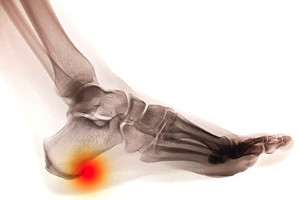 A condition referred to as a heel spur is typically caused by repetitive stress placed on the foot. Gradually, a small protrusion forms on the bottom of the heel, and often produces severe pain. As a result, walking may become difficult, which may affect the gait. Research has shown that it is suggested to stop the activity that has caused the heel spur to develop, followed by implementing proper treatment methods. These may consist of injections that to provide relief, in addition to performing stretching techniques that may help in maintaining an accepted level of comfort. Surgery may be an additional option for permanently removing the heel spur and improving the general mobility of the entire foot. Most patients experience heel pain which typically precedes a proper diagnosis, and should not be ignored. Please consider scheduling a consultation with a podiatrist for additional information on how to properly treat heel spurs.
A condition referred to as a heel spur is typically caused by repetitive stress placed on the foot. Gradually, a small protrusion forms on the bottom of the heel, and often produces severe pain. As a result, walking may become difficult, which may affect the gait. Research has shown that it is suggested to stop the activity that has caused the heel spur to develop, followed by implementing proper treatment methods. These may consist of injections that to provide relief, in addition to performing stretching techniques that may help in maintaining an accepted level of comfort. Surgery may be an additional option for permanently removing the heel spur and improving the general mobility of the entire foot. Most patients experience heel pain which typically precedes a proper diagnosis, and should not be ignored. Please consider scheduling a consultation with a podiatrist for additional information on how to properly treat heel spurs.
Heel spurs can be incredibly painful and sometimes may make you unable to participate in physical activities. To get medical care for your heel spurs, contact Kellvan Cheng, DPM from Elite Foot & Ankle. Our doctor will do everything possible to treat your condition.
Heels Spurs
Heel spurs are formed by calcium deposits on the back of the foot where the heel is. This can also be caused by small fragments of bone breaking off one section of the foot, attaching onto the back of the foot. Heel spurs can also be bone growth on the back of the foot and may grow in the direction of the arch of the foot.
Older individuals usually suffer from heel spurs and pain sometimes intensifies with age. One of the main condition's spurs are related to is plantar fasciitis.
Pain
The pain associated with spurs is often because of weight placed on the feet. When someone is walking, their entire weight is concentrated on the feet. Bone spurs then have the tendency to affect other bones and tissues around the foot. As the pain continues, the feet will become tender and sensitive over time.
Treatments
There are many ways to treat heel spurs. If one is suffering from heel spurs in conjunction with pain, there are several methods for healing. Medication, surgery, and herbal care are some options.
If you have any questions feel free to contact our office located in Carrollton, TX . We offer the latest in diagnostic and treatment technology to meet your needs.
Types of Flat Feet
 The condition referred to as flat feet occurs when the natural arch in the foot is absent. This typically becomes known when pain is experienced while standing for prolonged periods of time. Fallen arches is another term for this ailment and most babies are born with this condition. It generally disappears by age 3, although a small percentage of adults will endure discomfort associated with flat feet. There are several types of flat feet, including the most common which is typically referred to as “flexible flat foot.” This is evident when the arches appear only when the foot is lifted, and disappear when the foot is flat on the ground. Additionally, a flat foot condition referred to as short Achilles tendon may be experienced. The purpose of the Achilles tendon is to connect the calf muscle to the heel. If the tendon is not long enough, the heel may lift off the ground earlier than it should, and may possibly cause pain while walking. If you would like additional information about flat feet, please schedule a consultation with a podiatrist for proper treatment options.
The condition referred to as flat feet occurs when the natural arch in the foot is absent. This typically becomes known when pain is experienced while standing for prolonged periods of time. Fallen arches is another term for this ailment and most babies are born with this condition. It generally disappears by age 3, although a small percentage of adults will endure discomfort associated with flat feet. There are several types of flat feet, including the most common which is typically referred to as “flexible flat foot.” This is evident when the arches appear only when the foot is lifted, and disappear when the foot is flat on the ground. Additionally, a flat foot condition referred to as short Achilles tendon may be experienced. The purpose of the Achilles tendon is to connect the calf muscle to the heel. If the tendon is not long enough, the heel may lift off the ground earlier than it should, and may possibly cause pain while walking. If you would like additional information about flat feet, please schedule a consultation with a podiatrist for proper treatment options.
Flatfoot is a condition many people suffer from. If you have flat feet, contact Kellvan Cheng, DPM from Elite Foot & Ankle. Our doctor will treat your foot and ankle needs.
What Are Flat Feet?
Flatfoot is a condition in which the arch of the foot is depressed and the sole of the foot is almost completely in contact with the ground. About 20-30% of the population generally has flat feet because their arches never formed during growth.
Conditions & Problems:
Having flat feet makes it difficult to run or walk because of the stress placed on the ankles.
Alignment – The general alignment of your legs can be disrupted, because the ankles move inward which can cause major discomfort.
Knees – If you have complications with your knees, flat feet can be a contributor to arthritis in that area.
Symptoms
- Pain around the heel or arch area
- Trouble standing on the tip toe
- Swelling around the inside of the ankle
- Flat look to one or both feet
- Having your shoes feel uneven when worn
Treatment
If you are experiencing pain and stress on the foot you may weaken the posterior tibial tendon, which runs around the inside of the ankle.
If you have any questions please feel free to contact our office located in Carrollton, TX . We offer the newest diagnostic and treatment technologies for all your foot and ankle needs.
Symptoms of Poor Circulation in the Feet
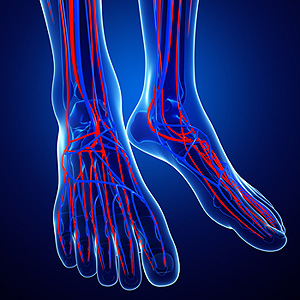 One of the first ways to tell if poor circulation exists in the feet is by the numbness and tingling that is often experienced. More severe examples may be a cold feeling that develops in the feet in addition to possible cramping. Poor circulation may be a symptom of vascular disease which often occurs with blocked arteries. When this occurs, the blood is not carrying adequate amounts of oxygen to and away from the heart, and this is often noticed in the feet. The development of sores on the feet may be a sign that poor circulation exists, and may have difficulty in healing properly. You may also notice a slower growth pattern in your toenails If you feel you may have poor circulation in your feet, speaking with a podiatrist is recommended.
One of the first ways to tell if poor circulation exists in the feet is by the numbness and tingling that is often experienced. More severe examples may be a cold feeling that develops in the feet in addition to possible cramping. Poor circulation may be a symptom of vascular disease which often occurs with blocked arteries. When this occurs, the blood is not carrying adequate amounts of oxygen to and away from the heart, and this is often noticed in the feet. The development of sores on the feet may be a sign that poor circulation exists, and may have difficulty in healing properly. You may also notice a slower growth pattern in your toenails If you feel you may have poor circulation in your feet, speaking with a podiatrist is recommended.
Poor circulation is a serious condition and needs immediate medical attention. If you have any concerns with poor circulation in your feet contact Kellvan Cheng, DPM of Elite Foot & Ankle. Our doctor will treat your foot and ankle needs.
Poor Circulation in the Feet
Poor blood circulation in the feet and legs is can be caused by peripheral artery disease (PAD), which is the result of a buildup of plaque in the arteries.
Plaque buildup or atherosclerosis results from excess calcium and cholesterol in the bloodstream. This can restrict the amount of blood which can flow through the arteries. Poor blood circulation in the feet and legs are sometimes caused by inflammation in the blood vessels, known as vasculitis.
Causes
Lack of oxygen and oxygen from poor blood circulation restricts muscle growth and development. It can also cause:
- Muscle pain, stiffness, or weakness
- Numbness or cramping in the legs
- Skin discoloration
- Slower nail & hair growth
- Erectile dysfunction
Those who have diabetes or smoke are at greatest risk for poor circulation, as are those who are over 50. If you have poor circulation in the feet and legs it may be caused by PAD and is important to make changes to your lifestyle in order to reduce risk of getting a heart attack or stroke. Exercise and maintaining a healthy lifestyle will dramatically improve conditions.
As always, see a podiatrist as he or she will assist in finding a regimen that suits you. A podiatrist can also prescribe you any needed medication.
If you have any questions please feel free to contact our office located in Carrollton, TX . We offer the newest diagnostic and treatment technologies for all your foot and ankle needs.
Causes, Symptoms, and Treatment of Poor Blood Circulation in the Feet
Poor blood circulation in the feet and legs is often caused by peripheral artery disease (PAD), which is usually the result of a buildup of plaque in the arteries. Plaque buildup, or atherosclerosis, can be the result of excess calcium and cholesterol in the bloodstream. This restricts how much blood can flow through arteries. Reduced blood flow to a certain area of the body severely limits the amount of oxygen and nutrients that part of the body receives. This leads to degeneration in the muscles and other tissues. Sometimes, poor blood circulation in the feet and legs can be caused by other conditions, such as the damaging or inflammation of blood vessels, known as vasculitis.
The lack of oxygen and nutrients caused by poor blood circulation can restrict muscle growth and development, as well as cause muscle pain and cramps, weakness, and stiffness. Other common symptoms include numbness in the legs and feet, skin discoloration in the affected limbs, slower nail and hair growth, and erectile dysfunction in men. In more severe cases of PAD, pain can be present even when a person isn't exercising, and may range from mildly uncomfortable to completely debilitating.
Poor blood circulation in the feet and legs is more common in those who are overweight or obese, have diabetes, high blood pressure, high cholesterol, who smoke, or who have a family history of PAD or related conditions such as a heart attack, stroke, etc. Diabetes and smoking place a person at greatest risk for developing poor blood circulation, although advanced age, over 50, can also increase risk.
If you are experiencing poor blood circulation in the feet and legs caused by PAD, it is important to make changes to your lifestyle in order to reduce your risk of experiencing a heart attack or stroke caused by this condition. If you smoke, quit completely. This will increase the amount of oxygen in your bloodstream. Exercising and reducing the saturated fats in your diet. Saturated fats come from fatty meats, fried foods, whole milk, etc., can make a difference in improving blood circulation in feet. It is also important to avoid developing influenza and to carefully control your blood sugar if you have diabetes.
Your doctor may recommend combining lifestyle changes with a prescription medication regimen to improve blood circulation. The most commonly-used medications for PAD are called statins and work by blocking the amount of enzymes in your body that produce cholesterol. They are known by the brand names Zocor, Lipitor, Crestor, and others.
Featured Articles
- June 2025
- May 2025
- April 2025
- March 2025
- February 2025
- January 2025
- December 2024
- November 2024
- October 2024
- September 2024
- August 2024
- July 2024
- June 2024
- May 2024
- April 2024
- March 2024
- February 2024
- January 2024
- December 2023
- November 2023
- October 2023
- September 2023
- August 2023
- July 2023
- June 2023
- May 2023
- April 2023
- March 2023
- February 2023
- January 2023
- December 2022
- November 2022
- October 2022
- September 2022
- August 2022
- July 2022
- June 2022
- May 2022
- April 2022
- October 2019
- September 2019
- August 2019
- July 2019
- June 2019
- May 2019
- April 2019
- March 2019
- February 2019
- January 2019
- December 2018
- November 2018
- October 2018
- September 2018
- August 2018
- July 2018
- June 2018
- May 2018
- April 2018
- March 2018
- February 2018
- January 2018
- December 2017
- November 2017
- October 2017

